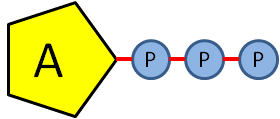Adenosine triphosphate (ATP)
Energy is needed for muscular activity to take place. The only useable source of energy in the body is a compound found in muscle cells called Adenosine Triphosphate (ATP).
All forms of biological work (digestion, production of hormones, transmission of nerve impulses, manufacture and repair of tissue) within the body require energy in the form of ATP.
All sources of energy found in the food that we eat have to be converted into ATP before the potential energy in them can be used. ATP is a high energy compound made up of one molecule of adenosine and three phosphates.
Special high-energy bonds exist between the phosphate groups and breaking one of the phosphate bonds releases the energy. ATP is broken down into adenosine diphosphate (ADP) and free phosphate (Pi) releasing the stored energy.
Read through the information on the structure of ATP and the way that is releases energy. Click on the link to open the animation.
Animation of the release of energy from ATP
The above link is an NLN resource - (c) LSC
The quantity of ATP in the muscles is very limited so once this breakdown has occurred the ADP needs to be resynthesised back into ATP to ensure the constant generation of energy within the body. Note that energy is required to resynthesise ATP and it is the energy we get from food that provides this.
The process by which ATP is resynthesised is called the ATP cycle and it is the body's energy systems that are responsible for this.


